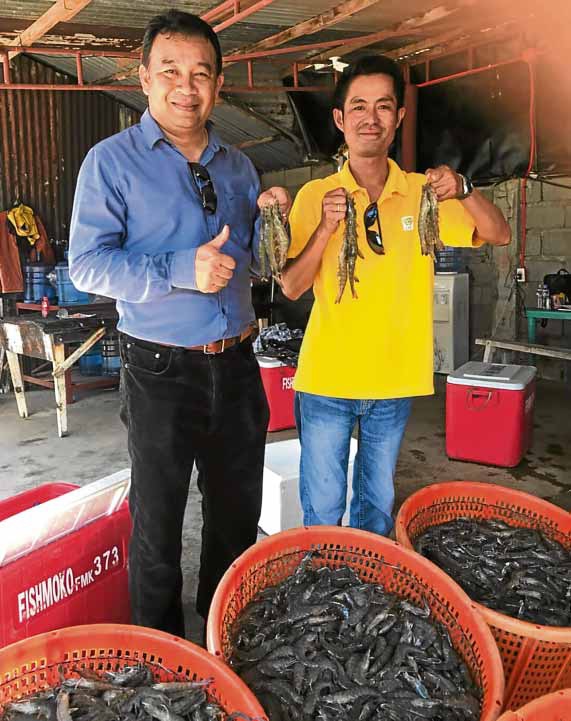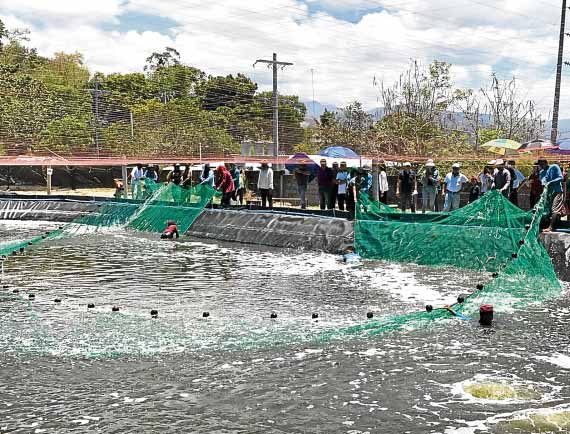Farmers may find white knight in white shrimp

CPF Philippines president Udomsak Aksorphakdee (left) and CPF Farm Zambales manager Amonchai display harvested shrimp.
Amid the blistering 40-degree heat, farmers, investors, bankers and other business partners from the different sectors of the shrimp industry gathered at the CPF shrimp farm in Zambales to witness the successful harvest of white shrimp (also known as Vannamei) from the pioneering Best Small Farm project.
Seeking to pave the way for a new era in aquaculture, CPF introduced the environment-friendly shrimp culture system to help Filipino shrimp growers achieve high productivity while keeping costs low and ensuring food safety.
The BSF’s main objective is to improve biosecurity in the farm and reduce the risk of disease contamination, which is the main threat in growing shrimp.
Spraying vehicles with disinfectant before entering the farm vicinity, putting up a crab fence and bird scaring device to ward off crabs and birds that carry diseases are among the must-haves under this new system.
Farm managers give value and importance to eliminating the risk factors of diseases through the 3C concept: clean fry, where PL (post larvae) are produced from CPF’s own hatcheries using SPF Brood Stock that carry high performance genetics that maximize shrimp growth, improve survival rates and resistance to diseases; clean water and clean pond bottom.
Article continues after this advertisementBy strictly adhering to these tenets, the 3C concept helps ensure the successful rearing of shrimp.
Article continues after this advertisementAlso, the standard size of the pond was reduced from the usual one hectare to just 0.16-0.25 hectares. The smaller size makes it easier to manage the farm and keep potentially deadly diseases at bay. At the same time, harvesting and pond preparation become more efficient, leading to a higher pond crop turnover.
All of these factors combine to make shrimp growing more financially viable.
The Best Small Farm Pond Demo in CPF Farm, Zambales harvested 8,500 kilos of shrimp from just 1,600 square meters. This gives the pond a productivity of 53 metric tons per hectare with a feed conversion Ratio (FCR) of 1.30.
The quality of the shrimp feed must be ensured considering that feed accounts for the biggest cost at 45 percent of shrimp production.
CPF Philippines has been consistently producing quality shrimp feed at its factory in Samal, Bataan since 2013. Indeed, it takes pride in propelling the growth of the shrimp business in the country.
The timing is ideal as shrimp is selling at around P360/kg. With production cost reduced to around P170 to P180 a kilogram through the CPF system, shrimp farming has become one of the most profitable businesses in the agriculture industry.
“CPF Philippines introduced new techniques to shrimp farming because it made business sense for CPF and the farmers. New technologies made our growers competitive. Likewise, Philippine farmers will get benefits from this technology and they will become more daring to try new technologies on the promise of higher yields and better returns,” said CPF country president Udomsak Aksornphakdee.
“Shrimp farmers are our lifetime partners, so we do business for development. We have established several different projects with the main objective that if farmers have sustainable income and better quality of life, the country will also progress,” he added.
This is in line with the company’s core value of sustainability, for the company, for the people, and the country.
